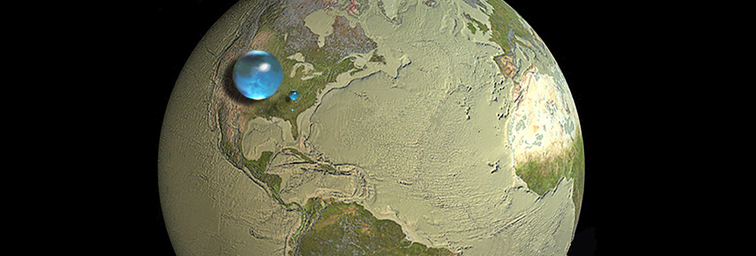
DYING OF THIRST: POPULATION GROWTH, CLIMATE CHANGE AGGRAVATE WATER SHORTAGES
- Leon Kolankiewicz
- September 29, 2015
- Forum Papers
- 0 Comments
Click here for a downloadable, printable PDF version
DYING OF THIRST: POPULATION GROWTH,
CLIMATE CHANGE AGGRAVATE WATER SHORTAGES
An NPG Forum Paper
by Leon Kolankiewicz
Water – Much More Than Just the “Universal Solvent”
Chemists refer to water – H20 or H-O-H – as the “universal solvent,” because it is capable of dissolving a wide range of different substances. In fact, more substances or chemical compounds can dissolve in water than in any other liquid.
Water’s unique chemical composition and physical properties are what make it such an excellent solvent. Each water molecule possesses a “polar” configuration of one oxygen and two hydrogen atoms – one side (hydrogen) has a positive electrical charge while the other side (oxygen) has a negative charge. This permits the water molecule to become “attracted” to many other different types of molecules. Water can be so strongly attracted to a compound like salt (sodium chloride or NaCl), that it can override the attractive forces that bind together the sodium and chloride ions in a salt molecule and thus dissolve it (USGS 2015).
The magic molecule
But to biologists and ecologists, water is more – much, much more – than the universal solvent. It is the stuff of life. Water is both integral and indispensable to all life on Earth (and perhaps the universe): human and non-human, plant and animal, vertebrate and invertebrate, microscopic and macroscopic, prokaryotic and eukaryotic, multi-cellular and unicellular, terrestrial and aquatic alike. Water occurs both inside and outside of the cellular membranes and biochemical walls that demarcate the boundary between biotic (living) and abiotic (non-living) matter. Up to 90 percent or more of the weight of healthy, living plant and animal tissue is water. The human body overall consists of more than 60 percent water, while our blood is 92 percent water[…]
- Earth Day and Population:A Missed Opportunity - March 14, 2017
- Crushing Biodiversity with the Weight of the Human Race - October 5, 2016
- DYING OF THIRST: POPULATION GROWTH, CLIMATE CHANGE AGGRAVATE WATER SHORTAGES - September 29, 2015
